To accompany Progeny Theatre Company’s marketing campaign we decided to find a unique way of advertising our company and our show. At first, as a company, we decided that it would be a beneficial idea to associate a phrase with our company – a tag line for Progeny Theatre Company. After developing our idea of making Children’s theatre for adults we decided to have “No one is too old for Fairy tales” as our main tagline. Following this I was playing around with other phrases and created “Once Upon a time will never be the same again…” The idea for this tagline was to intrigue our target audience into questioning why it would never be the same again, what is Progeny going to do with the well known “Once Upon a time”? As a company, Progeny wants to change the perception of a fairy tale, one way that marketing showed this was through this tagline. By stating that it will never be the same again, shows that performance will not be in the style of a traditional fairy tale and will change the way fairy tales are performed – within the company. These two taglines were used on our social networking sites – mainly on YouTube, Facebook and Twitter.
After these taglines were created the marketing team decided to exhibit these taglines in some way so that our audience could see them, more than them being on our social media sites. We wanted to create a closer relationship with our audience – in a sense face to face, rather through social networking sites. Due to the Progeny’s relationship to stories through adapting fairy tales, it was then decided to hand write our taglines onto paper and place them into books. Although we already had two taglines slowly becoming associated with Progeny Theatre Company, we thought it would be beneficial – for the tagging of books- to create a further two more taglines. These taglines would relate to our shows rather than Progeny as a company. One of the new taglines was our Show name ‘A Gothic Tale’ and the other would be a line from the play.
Choosing a suitable line from the script was not a simple process, which we first thought it would be. The line had to be comprehensible without much context of the play and spark the reader’s curiosity and attention. The line also could not reveal too much about the play – it had to be a teaser. Eventually – after talking to the rest of the company – a decision was made to use the Ex-wife’s line “He will do it again!” (Bull, Chanel, Smith 2013, p.12). I believed that this line would create an interest due to what it is saying, we hoped that the audience would question – who is he and what will he do again?.
Our taglines needed to be both catchy and mysterious enough to intrigue our target audience enough to find out what they were. We also had to have a way for the finders of our tag lines to know who created these tag lines. On these tags, we made sure that we had our company name clearly wrote at the bottom of all of the tags, we also hash tagged (a term used on Twitter) them so the finders knew that they could find us on twitter.
Jessica Smith and I then decided that, to help create the handwritten tags we would ask the group to create a few of each tag. I created a rough version of what the tags should look like and uploaded them to our private Facebook group. I told the group that all tags should be written like this – to keep them consistent – and that the tags should also be written in blue/black ink or pencil. I also noted to the group that these were rough versions and will not be used – and to ensure that the edges of the tags were cut neatly and straight
.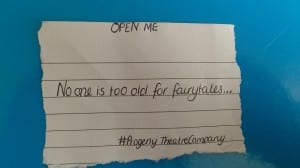
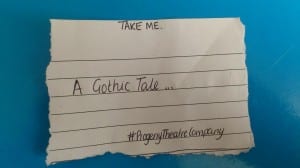
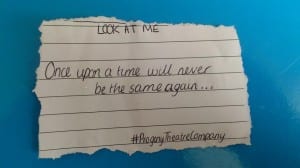
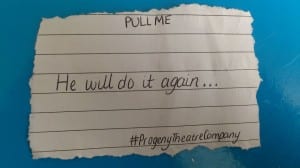
When the tags were completed properly and combined together, we wanted them to look as follows;

Photo of Alex Urbanczyk’s combined tags.
After the group created the tags we had created 300 small tags. The next step in this marketing activity was to gain permission from the library. This was done through emailing;
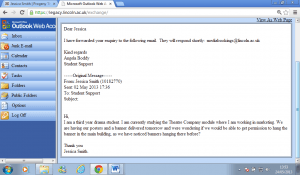
Once permission was granted we went ahead with our idea. As aforementioned our intention for tagging was to place our tags into books in order for people to find them, see our company name and become intrigued enough to search for us on the internet. This would hopefully further increase our target audience and social networking followers. After the tagging was complete we updated Progeny Theatre Companies Facebook status letting our current followers know that something was happening. This, again, was to build the relationship between the company and our audience – as well as gain new audiences. The status that tells the audience about the tagging begins with “Calling all students”.
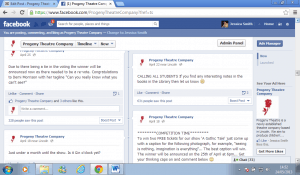
Facebook status – Calling all students!
Once the tags were hidden in differing books in the library, Progeny Theatre starting receiving picture twitter messages containing various tags that people had found. By people responding to our previously mentioned tweets and status about our tagging, showed us that it had created a line of communication between Progeny Theatre Company and our audience. This was shown through people tweeting Progeny Theatre Company and attaching pictures of the tags that they had found;
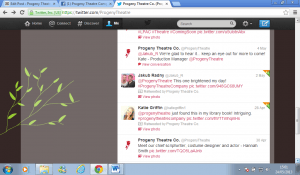
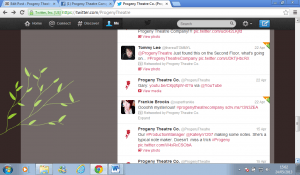
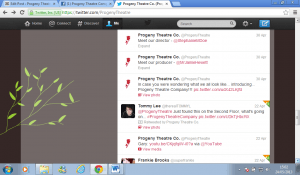
Although this way of marketing our show and our company did not reach as many people as our social networking sites, we believe it was a creative and unique way of gaining more audience and further building a relationship with them. By doing this type of marketing in the University Library focused on our relationship with our immediate audience and, hopefully, created a more interactive connection with them. By focusing this particular marketing activity in the University Library targets a large amount of our audience –Students of the University of Lincoln. By linking up both our tagging and social networking sites created a way for our new audience members (from tagging) to find us on Facebook and Twitter. The tagging also enabled people who don’t have Facebook to know who Progeny Theatre Company are, rather that primarily focusing on internet users.
Word Count – 1000
Works Cited
Bull, Rob, Lewis Chanel and Hannah Smith (2013) A Gothic Tale, Lincoln: LPAC









